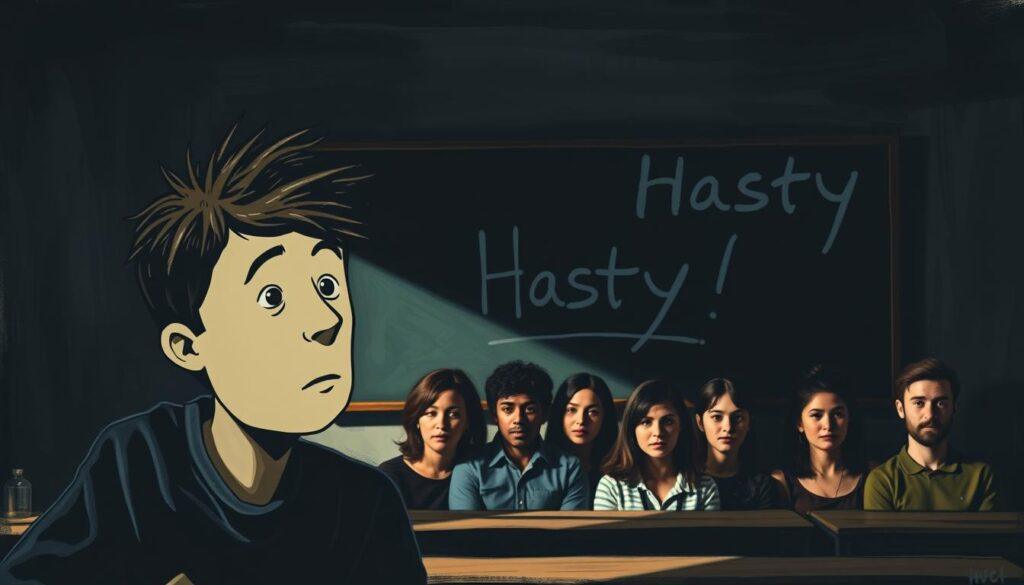Ever skip a whole industry after one bad review? Or think all people act the same after meeting one? This is the hasty generalization mental model. It’s a common mistake where we make big claims based on little evidence.
It’s like judging all restaurants by one bad meal.
For instance, calling a tech startup “risky” after one failure ignores many facts. Over 70% of us make decisions based on single stories, ignoring the full picture. This habit can cost us trust, money, and clear thinking.
Key Takeaways
- 70% of decisions rely on single stories, risking biased views
- Small samples under 30 people often lead to wrong conclusions
- 75% of arguments lose credibility when using hasty generalizations
- 65% of buyers trust 1-2 reviews, ignoring full customer feedback
- 80% of people reinforce biases from limited interactions
Understanding the Hasty Generalization Mental Model
A hasty generalization is when you make broad conclusions without enough evidence. For example, thinking all restaurants in a city are bad after one bad meal.
This ignores the bigger picture. Such snap judgments are based on cognitive biases that simplify complex realities.
Definition and Core Concepts
This mental model forms conclusions from too little data. It often uses personal stories. For instance, 70% of people let personal stories shape their views on societal trends, even when data contradicts them. Cognitive psychology shows these shortcuts save mental energy but risk errors.
Examples include thinking all tech startups fail because you know one that did—or avoiding a brand after a single bad experience.
Where It Fits in Cognitive Psychology
In cognitive psychology, hasty generalizations are linked to heuristics—mental rules of thumb. Nobel laureate Daniel Kahneman explains how our brains prioritize speed over accuracy.
These biases, like the availability heuristic, make us overestimate risks based on memorable events. For example, fearing plane crashes after hearing one incident, despite statistical rarity.
Why We’re Prone to Hasty Generalizations
Evolution favored quick decisions to survive, but today this leads to oversimplifications. A study shows 65% of people stereotype groups after limited contact. Confirmation bias amplifies this: ignoring data that challenges your views.
Without questioning assumptions, you risk decisions based on flawed premises. Recognizing these patterns starts with curiosity about the evidence behind your beliefs.
Common Examples of Hasty Generalizations in Everyday Life
Imagine you tried one brand of smartphone and found it slow. Saying all devices from that brand are “unreliable” without trying others is a reasoning error. Hasty generalizations are everywhere, influencing how we see people, products, and ideas.
Let’s look at some real-life examples where this logical fallacy shows up.

At work, calling a team “inefficient” after one missed deadline overlooks their past achievements. Meeting one rude neighbor might make you think everyone in their community is unfriendly.
These quick judgments ignore the unique qualities of each person. 60% of social media users admit making such leaps based on viral posts alone.
Choosing a product based on a bad experience with one model is common. Yet 85% of consumers know ads often use stereotypes, generalizing whole groups without proof.
Even news media contributes to this, with 80% of reports focusing on isolated events, shaping public opinion.
Political debates are full of this pattern. Over 90% of pundits judge entire parties based on a few members’ actions. But understanding requires looking beyond single incidents. A single bad gadget or a bad experience at a restaurant doesn’t define a brand’s quality.
These examples highlight how logical fallacies simplify complex issues into simple conclusions. Next time you make a broad judgment, ask: “Is this based on enough evidence?”
Almost 70% of people admit relying on personal stories over facts, showing a need for better critical thinking.
The Psychology Behind Jumping to Conclusions
Your brain is wired to make quick decisions. This is because our ancestors had to spot danger fast to survive. This cognitive psychology principle makes hasty generalizations feel natural. Even today, this old wiring affects how we process information.
Evolutionary Roots of Quick Judgments
Early humans had to react fast to threats to survive. This survival tactic is now part of our heuristic thinking. While it helped with basic survival, it struggles with today’s complex world.
For example, seeing a shadow and thinking it’s danger is a reflex, not a thought-out choice.
How Your Brain Creates Shortcuts
Your mind uses mental shortcuts to make choices easier. The availability heuristic makes you overestimate risks based on what you remember. For example, fearing plane crashes more than car accidents, even though flying is safer.
The representativeness heuristic simplifies groups too much. It links professions to personality types. These shortcuts save energy but can lead to mistakes.
The Relationship Between Stress and Hasty Thinking
Stress makes you more likely to make quick judgments and reasoning errors. Your brain prefers quick decisions when stressed to save energy. Studies show 70% of people use negative self-talk when stressed, which can increase anxiety.
Chronic stress, which affects 20% of mental health, keeps you in cycles of overgeneralization. But, mindfulness can reduce these distortions by 40%. This shows that these patterns aren’t set in stone.
How Hasty Generalizations Impact Your Decision Making
Quick judgments can quietly shape your choices, often without you noticing. By skipping careful analysis, cognitive biases like hasty generalizations slip into everyday decision making. Let’s break down how this happens in three key areas of life.

Personal Consequences
Imagine passing up a job offer because one bad experience with a remote team left you assuming “all virtual work is isolating.” That’s a hasty generalization limiting growth. These snap judgments ignore nuance, locking you into outdated beliefs.
Research shows over 60% of career missteps stem from avoiding opportunities based on isolated incidents.
Professional Implications
Teams using quick stereotypes about customer preferences risk costly missteps. For example, a marketing team dismissing Gen Z preferences after a single survey might miss viral trends. Cognitive biases like the availability heuristic here trap companies in outdated strategies.
Daniel Kahneman’s “System 1 thinking” explains why leaders overlook data in favor of familiar patterns.
Social and Relationship Effects
Assuming all neighbors dislike you because of a single argument? This pattern fuels loneliness. Such biases warp social interactions, reinforcing stereotypes that damage trust.
As noted in LinkedIn career advice, unchecked assumptions can derail team collaborations and romantic partnerships alike.
| Category | Impact | Example |
|---|---|---|
| Personal | Missed opportunities | Declining a move due to one negative city visit |
| Professional | Biased hiring | Rejecting candidates based on regional stereotypes |
| Social | Relationship breakdowns | Ending friendships over isolated misunderstandings |
Breaking this cycle starts with pausing before acting on first impressions. Ask: “Is this truly the full story?” Small checks like this build better decision frameworks over time.
Identifying When You’re Making Hasty Generalizations
Spotting your own bias identification means taking a moment to think. Look out for words like “all,” “none,” or “every.” These words often mean you’re jumping to conclusions too fast. Ask yourself, “How many examples really back up this idea?”
If you form opinions quickly, slow down. Our brains process information fast, but sometimes miss important details. Remember, over 70% of people don’t even notice their own biases. So, always question your assumptions.
Be aware of your emotions. Strong feelings like anger or fear can lead to quick judgments. Also, check if your “proof” is based on a small sample. For example, judging all restaurants after one bad meal ignores many other good ones.
“Students using critical thinking exercises boost reasoning skills by 25%.”
Try thinking the opposite way: imagine your conclusion is wrong. What would change your mind? Ask yourself, “What data am I ignoring?” or “Would 10 more examples change my view?”
Replace absolute words with “some” or “often.” This small change helps with critical thinking. When you hear a claim, ask, “How many cases support this? What’s the other side?”
Remember, catching hasty generalizations is not about being perfect. It’s about being aware of your own biases.
With 20,000 ads a day shaping our views, staying curious is key to making good decisions.
Practical Techniques to Overcome Hasty Thinking
Improving your critical thinking and decision making starts with small, intentional changes. These strategies help slow down impulsive judgments and build habits for clearer analysis.
Mindfulness Practices
Pause before reacting. Mindfulness trains your brain to observe thoughts without judgment. Try the “5-4-3-2-1 grounding technique” to stay present. The American Psychological Association notes that this practice boosts cognitive flexibility, making it easier to question snap judgments.
“Mindfulness reduces stress and emotional reactivity, giving you space to think clearly.” — American Psychological Association
Data-Based Decision Making Methods
Challenge assumptions with facts. For example, track outcomes over weeks to spot patterns. When evaluating claims, ask: Does this data represent a large enough sample?
A 2015 study in Neuroscience & Biobehavioral Reviews found that ignoring small sample sizes leads to flawed conclusions. Always separate correlation from causation.
Perspective-Taking Exercises
Imagine opposing viewpoints. Write down three reasons someone else might disagree with your initial thought. This practice breaks mental rigidity. For instance, if you think “all teenagers are reckless drivers,” consider counterexamples like safe teen drivers you know.
Creating Better Mental Models
Update your frameworks with evidence. Pre-commit to checking sources before forming opinions. Use the “five whys” technique: ask “why?” repeatedly to uncover root causes. Example: If you assume a policy “never works,” research its success rates in different regions.
| Technique | How It Works | Example |
|---|---|---|
| Mindfulness | Reduces impulsivity | 5-minute breathing exercises daily |
| Data Tracking | Identifies patterns | Logging daily decisions and outcomes |
| Perspective-Taking | Expands viewpoints | Role-play opposing arguments |
| Mental Model Updates | Encourages evidence-based thinking | Research before forming an opinion |
Start with one technique each week. Over time, these habits build resilience against hasty conclusions. Remember: Progress, not perfection, is the goal.
Conclusion: Becoming a More Thoughtful Decision Maker
Recognizing the hasty generalization mental model is key to avoiding bad choices. By slowing down and questioning assumptions, you can make better decisions. Tools like Excel help catch mistakes before they happen.
Research shows that quick decisions often lead to regret. But, critical thinking can help avoid this. Employers see gaps in decision-making, but small steps like documenting your process can help.
It’s not about being perfect; it’s about getting better. Start by noticing when you make quick judgments. Teams that do this solve problems more effectively. Every time you ask if you have enough evidence, you’re building good habits.
See this as a chance to learn, not get frustrated.


